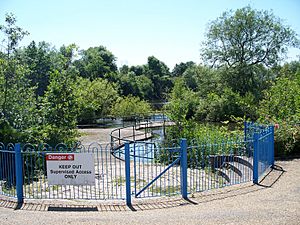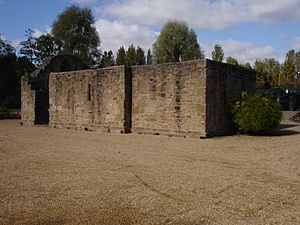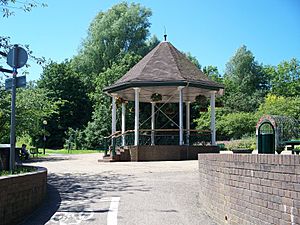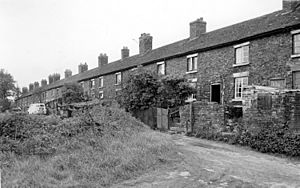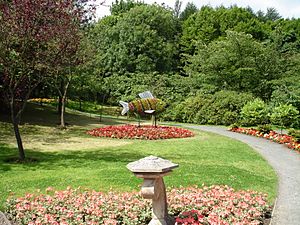Telford Town Park facts for kids
Telford Town Park is a large park and a special Local Nature Reserve in Telford, Shropshire. In 2015, people voted it "UK's Best Park" in a big competition run by Fields in Trust. It's a great place for fun, learning, and enjoying nature!
Contents
A Look Back: The Park's History
Long, long ago, in Saxon times, people started clearing parts of the forest here. They made farms, which grew into towns like Dawley and Malinslee. The word 'Ley' in Anglo-Saxon means a clearing in the wood, showing how these places began!
Later, in the 1200s, much of the land around Stirchley was given to monks from Buildwas Abbey. These monks built a farm called the Grange at Stirchley and worked the land until the 1530s.
Things changed a lot during the Industrial Revolution. This was a time when many factories and mines were built. People dug up valuable materials like coal and iron. This created huge piles of waste, which you can still see as hills in the Park today! The Shropshire Canal also ran through the Park, and new industries like iron factories grew up next to it.
The Randlay Chimney was built in 1873, but it was never used because the company went bankrupt. Later, another company used the site to make chemicals, but the smell made people complain! The last mine, Grange Pit, closed in 1894. Even with all this industry, nature slowly started to take over again. The old mine waste piles became small heathlands and woodlands. Hedges grew along the old canal and railway tracks, and old quarries turned into peaceful pools.
In the 1970s, a group called Telford Development Corporation (TDC) created what we now know as Telford Town Park. Their goal was to make a big green space, a "Green Lung," right in the middle of the new town. By 1984, the Park had grown to 170 hectares (that's like 420 football fields!). In 1992, the Park was given to the local council, which is now Telford & Wrekin Council.
Old railway lines also ran through the park. One of these, the Coalport Branch Line, later became the Silkin Way, a popular walking and cycling path. In 1980, a small Telford Town Tramway even opened in the Park, and it was opened by the Reverend W. Awdry (who wrote the Thomas the Tank Engine books!). The tramway only ran for a few years, but the tram itself is now preserved at the Telford Steam Railway.
Exciting Park Projects
The "Parks for People" project is a special plan to make the park even better! It's a joint effort by the Heritage Lottery Fund and Big Lottery Fund. Telford & Wrekin Council got approval for this big project.
This 5-year project started in 2011. Some of the plans included a new activity area for teenagers, new learning zones, and picnic spots. They also worked to fix up important historic parts of the park. Most of this work was finished by summer 2012.
More improvements are still happening, like better paths, a new Nature and Heritage Trail, and new signs to help you learn about the Park's history and wildlife. There will also be more fun events and activities from 2012 onwards!
The Park is easy to get to. It's just off Junction 5 of the M54. You can walk there in about 10 minutes from Telford's main bus station, or drive in 5 minutes from Telford Central railway station.
Telford parkrun
Telford parkrun is a free, weekly 5km run, jog, or walk that happens every Saturday morning. It's super popular with people of all ages and abilities! On average, about 600 people take part each week, helped by amazing volunteers.
Special Memorials
There are a couple of important memorials in the park:
- In May 2010, a memorial was unveiled to remember people from the Telford and Wrekin area who died serving their country since World War I. It was made by Malcolm Sear and has a central iron poppy. The words on it say: "Honouring those of this borough who served and sacrificed for us all."
- A memorial to remember the Holocaust was unveiled on Holocaust Memorial Day on January 27, 2014. It helps us remember a very sad time in history and the importance of peace.
Nature's Wonders: Plants and Animals
The 62-hectare Local Nature Reserve part of the park is home to woodlands, heathlands, grasslands, and pools. These different areas have grown because of the park's industrial past.
Plants (Flora)
The park's history has shaped the plants and habitats we see today. Long ago, it was mostly thick woodland. Then, Saxon farmers cleared land for farms. During the Industrial Revolution, much of the park became spoil mounds (waste hills) and quarry pits.
But since the industries left, nature has bounced back! The old mine mounds are now heathland and grasslands. The old quarries have become lakes and ponds. Woodlands, bushes, and hedges have grown up everywhere, even along the old canal and railway lines. This mix of habitats means lots of different plants can grow here.
Animals (Fauna)
The park is home to many amazing animals, including some endangered species! Surveys have found two of Britain's sixteen types of bat living in the park. To keep them safe, special bat boxes have been put up around the area.
The most common mammal you'll see in the wooded areas is the grey squirrel. Other small mammals like voles, shrews, and mice are likely here too, even if they're harder to spot.
Four out of Britain's five types of amphibians live in the park, including the smooth newt and the great crested newt. You can also find common frogs and toads.
Because the park has a mix of woodlands, bushes, water, and grasslands, it's a perfect home for many different birds. Over 60 types of birds have been seen here, including herons and black-headed gulls!


